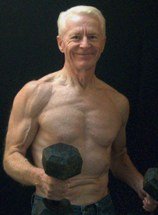| Back to Back Issues Page |
 |
|
The Gray Iron Fitness Newsletter, Issue #341. Pushing the limits. February 15, 2023 |
Hi
Pushing the Limits
For a long time one of the things most frequently asked by seniors has been about High-Intensity Interval Training (HIIT). In short, they want to know if they should do it. Here’s what I know. High-intensity intervals are great for overall physical conditioning and they also burn off fat better than, say, aerobics such as long slow distance running. But the question then becomes: is high-intensity training age-appropriate (meaning safe) for seniors? For young seniors, let’s say those in their 50s, who are in pretty decent shape and with no prohibitive underlying health problems, the answer is an easy yes. However, as we get older the answer is not so clear-cut. For older seniors, just how intense should exercise be? Are we talking about, for example, Tabata? That’s pretty tough stuff for the very elderly. Interval training can be good at almost any age, but maybe there comes a time when the intensity should be toned down. For senior beginners of all ages, and especially overweight senior beginners, a much smarter approach than HIIT is to ease into training with a beginners’ strength and fitness program. Then, later on, higher-intensity intervals may come into play. Until I was 80, I’d sneak in some Tabata, maybe once a week or so. Now at 86, I don’t go near that kind of intensity. Any exercise I do isn’t nearly as intense as it used to be. I simply keep up a steady movement for about 30 minutes, sometimes combining resistance work with light cardio. Years ago, a newsletter subscriber, Franco, sent this wonderful quote from the actor/comedian Dick Van Dyke. "In my 30s, I exercised to look good. In my 50s, to stay fit. In my 70s, to stay ambulatory. In my 80s, to avoid assisted living. Now, in my 90s, I'm just doing it out of pure defiance." —Dick Van Dyke. People also ask about the high-intensity programs they see in TV infomercials. Most of those programs aren’t sustainable for seniors, at least not for me personally. Not as they are shown on TV anyway. Even when I was young I didn't believe in pushing myself to the limit workout after workout, as in HIIT. On the few occasions, I tried going all out at every session, I soon began to dread training. Extreme training gets riskier as we get older. Be smart. Older folks should let their doctors know what they’re up to. And if HIIT is part of your plan (you younger seniors), ease into it. Don't jump in at full-throttle. Here are a few workout guidelines that I almost universally recommend:
There is a training lifestyle for every taste and to meet every fitness goal. Stay healthy. Stay fit. Logan My Photographs: Subscribers have asked when the newsletter photo at the top of the page and my website pictures were taken. The photos were taken when I was a mere 70. I’m 86 years old now. Though I remain active, I am no longer nearly as muscular as I was 16 years ago. —LF Are you on Facebook?Check out the Senior Exercise Central page at . . . https://www.facebook.com/GrayIronFitness
I search the Internet for senior health and fitness items. If you like what you see, please click the Like button. It helps me. Spread the word. If you like the newsletter, we're making it easy to share it Newsletter Policy The Gray Iron Fitness Newsletter is a free publication sent twice monthly to subscribers. The purpose is to provide honest and realistic fitness information for people age 50 and above. I have never been paid or received compensation of any kind to write a positive review or endorse a product. If I say that I personally use a product or service, it is because I find value in it and have paid for it with my own money. Like newspapers, magazines, and television, this newsletter and my website contain advertising and marketing links. Naturally, I am compensated for these. The newsletter and website provide information to help users establish and maintain a fitness lifestyle. But fitness information is not the same as fitness advice, which is the application of exercise and dietary practices to an individual's specific circumstances. Therefore, always consult with your physician for assurance that fitness information, and your interpretation of it, is appropriate for you. Your comments and questions are always appreciated. Simply click on the "Reply" bottom. |
| Back to Back Issues Page |